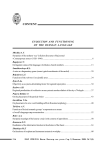Вестник Волгоградского государственного университета. Серия 2: Языкознание @jvolsu-linguistics
Статьи журнала - Вестник Волгоградского государственного университета. Серия 2: Языкознание
Все статьи: 1663

Analiza jedne pjesme: rezultati metodoloskog eksperimenta
Статья обзорная
The article is devoted to the methodological experiment aimed at finding out common and differentiating features in several interpretations on one poem. The author proves that methodologically diverse linguistic analysis and literary criticism concentrate on identical text fragments and come to similar conclusions, as opposed to the interpretations based on the author's commentaries.
Бесплатно
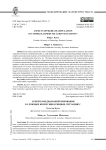
Aspects of media manipulation in complex communication situations
Статья научная
The article examines the forms of manipulation in complex communication situations, the essential component of which is multidirectionality, i.e. individual communicative acts addressing multiple audiences. Since complex communication situations are multidirected, they involve various participants who are direct interlocutors, moderators, communication observers, etc. The paper discusses the phenomena of the communicative action orientation towards multiple audiences in staged communication and the participation of the manipulated audience in Internet communication. Multidirectional communication is typical for advertising and talk shows. Although the speakers in talk shows address their interlocutors directly, their statements are perceived by the audience in the studio and the TV viewers. This situation can have a manipulative effect since the latter are not aware that they are the intended recipients. In commercials, characters explain the benefits of a product to other participants in the staged communication event. However, the communication is aimed at the TV audience, which is involved in a large-scale manipulation. From the point of view of manipulation theory, questions arise, such as the effects of monitoring communication (passive participation), the extent to which the recipient themself is part of the manipulation and the responsibility of the recipient and participant of communication in a communicative event.
Бесплатно
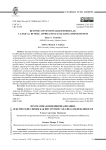
Beyond Conventionalized Formulae: A Lexical Bundle Approach to Analyzing (Im) Politeness
Статья научная
The paper introduces a frequency-driven lexical bundle approach to enhance politeness research by addressing the limitations of traditional corpus pragmatics approaches, which assume pre-defined (im)politeness values for linguistic forms. While politeness is widely recognized as a dynamic context-dependent phenomenon, corpus pragmatics research risks overlooking its variability by focusing on pre-selected politeness formulae, such as thank you, please, sorry, etc. The lexical bundle approach builds on the concept of conventionalization, defined as the process by which linguistic expressions acquire politeness-related meaning through repeated use in a specific context. The proposed approach focuses on the identification of recurring multi-word sequences (lexical bundles), capturing how they index (im)politeness in discourse. We demonstrate the utility of this approach through a case-study of Wikipedia editors' communication, where politeness is strategically negotiated in collaborative, consensus-driven dialogue. By analyzing discussions from Wikipedia talk pages, we categorize the extracted bundles into two groups: conventionalized politeness formulae, which consistently index collaborative politeness across Wikipedia's editorial discourse (e.g., what do you think, is it possible to) and multifunctional expressions, that manifest variable politeness-related meanings (e.g., why don't you, am I missing something). This distinction reveals how politeness emerges through both stable norms and context-sensitive strategies. Our findings also highlight the capacity of the new approach to bridge Terkourafi's frame-based theory with empirical analysis, offering a replicable framework for studying (im)politeness as a co-constructed interactional practice.
Бесплатно
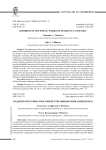
Buddhism in the poetic works of innokenty annensky
Статья научная
The importance of the work is determined by the place which I. Annensky occupies in Russian poetry and his unrelenting influence on generations of readers. The purpose of the work is to reveal the presence and linguistic ways of implementing the semantics of the Buddhist understanding of the world in the poetic heritage of I. Annensky. The material for the study is all original poems of the poet. The main methods are semantic, comparative and intertextual analysis. From the days of his study at the university, the poet was well acquainted with the basics of Buddhism and demonstrated obsession with it throughout his life. Several poems undoubtedly present semantic complexes that are directly referred to Buddhism, refurbishing its major provisions. The ways of translating Buddhist semantics are diverse and they are always organically interwoven into an artistic whole. The language of the poet is consistently focused on ambiguity, uncertainty and ambivalence, which is manifested at various text levels. The work lists the main language transformations used by the poet. It is illustrated on the example of the poem “”, which mysteriousness steadily draws the attention of readers and researchers. The author shows that the poem realizes the Buddhist conception of the ratio of extremely small and infinitely large quantities, implying their identity. The authors draw a parallel between the lines of I. Annenskyand W. Blake which implement identical Buddhist ideas. The conclusion outlines the prospects for a detailed analysis of other texts.
Бесплатно
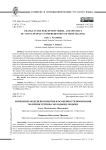
Change in the perception model and specifics of young people's comprehension of term meaning
Статья научная
The article discusses some changes that have been taking place in particular structures of mental lexicon. It presents the results of linguistic experiment aimed at revealing some shifts in perception of terms resulting from global virtualization of reality, which greatly affects all the structures of language consciousness, and transformation of information perception processes due to computerization. A new test was developed and used to get true information about dominant perceptional modality of the experiment participants. The results of the first stage of the experiment show that during the period of eleven years (2010-2021) the perception model of people aged from 18 to 20 has been shifting towards a digital type, when comprehension of a word meaning is based on logic, real facts, proofs. Some possible reasons for digital modality prevalence, the use of visual modalityas an auxiliary tool for the digital representational system, decrease in the significance of kinesthetic and auditory modalities are described. The results of the second stage of the experiment reveal a rather high level of emotional attitude to the stimuli connected with the professional sphere of digital generation. In this case the psychological emotionality of term meaning implies great interest, involvement and good understanding of the notion.
Бесплатно
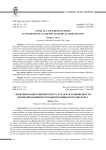
Clinical case presentations: an overview of an exemplar medical speech event
Статья научная
Clinical case presentations are core medical speech events carried out in medical and teaching institutions worldwide among both students and active practitioners. While in most non-English speaking locales these events will usually be communicated in a local language they are also, on set occasions, often performed in English. In order to understand both how and why clinical case presentations are carried out in English in non- English speaking Asian locales, the author visited 8 medical universities and/or affiliated hospitals in 6 Asian countries, observing a total of 36 English clinical case presentations, followed by interviews with 25 different clinical practitioners, teachers, or medical students. The author then analyzed the collected speech event data in terms of Hymes’ (1974) SPEAKING model, augmented by Swales’ (1990) focus upon ‘moves’ in genre analysis, and further informed by Bhatia’s (1994) introduction of a socio-cognitive dimension to genre analysis, in order to develop a well-rounded descriptive synoptic model of how this speech event is both perceived and performed in non-English speaking English settings. It is hoped that these insights can be further applied to the development of English for Medical Purposes (EMP) materials or curricula and that this case may serve as an exemplar for other inquiries into professional, situated ESP speech events.
Бесплатно
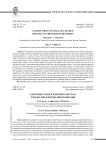
Closed topics in linguocultures: identity in the form of diversity
Статья научная
The present article deals with the meaningful and functional characteristics of the closed topics, that are the topics which are thought to be improper (taboo), and they are blocked in Russian, English and Chinese communication in a variety of ways. Their characteristics have not received a proper description in scientific works; therefore the study, based on the methods of semantic and communicative analysis, survey and comparison of the communication ways in different languages, aimed at filling the gap in probative identification of a list of closed topics, seems to be a current matter of interest. The authors use the term closedness and view it as an indicator of topic’s irrelevance that manifests itself with various language means. The article demonstrates the presence of a commonly shared list of closed topics in the above mentioned cultures. The possibility of reference to such topics in conversation is regulated by communication format, purpose and the degree of contact’s intimacy. The strategies of closed topic avoidance are marked with semantic replacement called mitigation and euphemism substitution. The study results ascertain that the closed topic list is shared by the Russian, English and Chinese cultures, but points to some differences in the way the conversations go. In conclusion the authors give a wide range of applications: from theoretical constructs that describe the mechanism of communication processes flow to the specific recommendations for optimizing communication in different spheres of human interaction.
Бесплатно
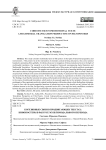
Cohesive Ties in Promotional Texts: A Multimodal Translation Perspective on Film Posters
Статья научная
This study considers multimodal texts of film posters in the light of functional pragmatics and intersemiosis. Film posters lie at the intersection of cinematic and advertising discourses, they cross national boundaries promoting films globally. It informs about our investigation of these promotional texts in the light of multimodal translation. Our research is set in the integrative framework encompassing Social Semiotics and Multimodal Translation. The material includes multimodal texts of film posters in English and their counterparts localized for the Russian audience. The sample texts are analyzed at the levels of meaning-building and reception. We examine cohesive linkages between different semiotic modes in the original posters, then we reveal if these ties are preserved or broken in the course of multimodal translation. Finally, we analyze how the translated versions are perceived by the Russian-speaking viewers. To this end, we conduct an experiment in the form of an interview. The findings reveal that the semantic ties uniting verbal and pictorial elements are not always rendered accurately in the course of multimodal translation, which tends to be assessed negatively by the recipients. However, some participants of the experiment positively evaluate localized posters with broken cohesive links finding them intriguing. It goes in line with the main pragmatic functions of advertising texts as they should not only inform but also stimulate interest in the film, intrigue being a powerful tool to do it. Our empirical study establishes correlation between the genre characteristics of a multimodal text and the perception of its intersemiotic ties.
Бесплатно
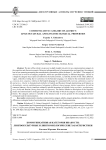
Communicative category of alterity: linguocultural and linguoecological properties
Статья научная
The aim of the article is to give an in-depth insight into alterity as a communication category in the cognitive and discursive aspects. Being an indispensable part of communication and cognition, the category has its own meaning presenting the communicative interaction within the frame “I - the Other”. The category of alterity has its own set of category properties, which are specified uniquely in different languages. Alterity as a linguistic category may express an outlook on the reality (similar, i.e. familiar, devoid of risk: other, different, vague, evidently evoking fear or curiosity). In the Russian language, it is linked to the emotional clusters of curiosity , fear , suspense , whereas in the English language it is associated with curiosity , admiration , surprise and novice . Alterity is characterized similarly in English and Russian through maintaining such features as dissimilarity , variety , multifariousness , belonging to different classes / groups , distinct opposition . As well as common features, alterity manifests culturally specific meanings in English ( being eccentric , revolutionary , new , fresh ) and Russian ( being funny and incongruous ). The article includes a description of the linguistic means and communicative strategies and tactics, with the help of which the category of alterity is realized in fiction. The category content is variable in the discourse and it serves ground for the ecological and non-ecological mode of communication.
Бесплатно
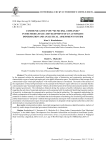
Статья научная
The article examines the issue of representing municipal government in the media space, followed by the proposed solution for automatically identifying signs of destructive and constructive positioning of communicative types of municipal employees in the public information space. The definition of the concept of the communicative type “municipal employee” with verification features is introduced. The results of the analysis of the organization of local self-government on the example of the Moscow region allowed us to conclude that the communicative type “municipal employee” reflects a diversified system of territorial communicative position within the regional government. The information obtained during the analysis of public information space attitudes regarding the activities of municipal employees can be automated with the method of identifying linguistic markers of emotivity to determine the communicative position of territorial authorities. The suggested methodology for effective automation of the studied subject area in the humanities has been verified as possessing a high scientific potential for further research. It is concluded that the development of technology for monitoring and forecasting public threats based on “soft power” methods through automatic and expert work to identify markers of evaluative presentation of communicative types of municipal employees is designed to help regional authorities achieve the desired results in ensuring territorial identity.
Бесплатно
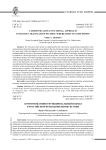
Communicative-functional approach in Russian translation studies: where does it come from?
Статья научная
The relevance of the article is conditioned by the vital need to comprehend prerequisites of the communicative-functional approach to translation in Russian translation studies, which, in its turn, will help reveal the inner logic of the development of translation studies, the logical changes of translation scholars’ thinking, predetermined by the turns in the science itself as well as define perspectives of Translation Studies development. Grounded on a thorough analysis of the theoretical provisions voiced in the works of the founders of Russian Translation Studies, the article highlights the essence of the communicative-functional approach to translation: unlike a purely linguistic, text-oriented approach, the communicative-functional approach investigates a translation event in the framework of a specific communicative situation within which the translation is done, taking into consideration both linguistic and extralingual factors (e.g. communicative intention of the Source Text Sender, the character of the communicative effect produced on the Target Text Recipient, etc.) that influence the translation process and its outcome. The diachronic analysis of the basic categories and concepts of the communicative- functional approach is provided, the structure of interlingual and cross-cultural communication is described, the concepts of “communicative intention”, “the text’s dominant function”, “communicative effect” and some others are redefined. The merits of the communicative-functional approach to theoretical investigation and practical realization of various types of translation, including simultaneous interpreting, in specific communicative situations are demonstrated and substantiated.
Бесплатно
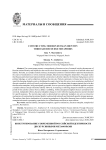
Constructing modern Russian identity through discourse metaphors
Статья научная
The current paper presents a comprehensive literature review of research into the phenomenon of Russian national identity and emphasizes the crucial role of discourse metaphor in narratives of national culture and identity. The latter, as a complex mental construct, encompasses common or similar beliefs or opinions internalized in the course of socialization as well as emotional attitudes, behavioural and linguistic dispositions. The paper claims that Russian patriotism-based national identity construction is directly related to the historical background, current political ideology, as well as objectives and tasks the state sets. Patriotic sentiments in Russia tend to boost due to some life-changing dramatic events or challenges the countryhas to face; this gives rise to employing a multitude of discursive practices, which relyheavilyon discourse metaphors. The relevant point the paper proposes lies in the fact that discourse metaphors, being conceptuallygrounded, serve as a pervasive cognitive mechanism applied to explain a complex abstract concept of national identity. However, its meaning is still being shaped in relation to a particular period of time and the context where a debate is unfolding. Unlike conceptual metaphors that are considered to be universal, independent of time, discourse metaphors change or evolve within the ongoing discourse and are intended for specific purposes. The current paper seeks to demonstrate how particular metaphors can serve as discursive mechanisms of constructing the national identity to achieve both culturally and historically specific strategic purposes. The authors claim that a combination of co-occurring metaphors in the public discourse forms a holistic extended metaphorical narrative promoting a particular view of Russianness and focus on some of them.
Бесплатно
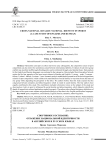
Cross-national rivalry: national identity in sports (a case study of English and Russian)
Статья научная
Nationalism and sport are often interwoven and, subsequently, the competitive nature of sport competition can also mirror the contentious nature between international athletes. Evidence of such inter-group conflict may manifest itself through ethnolinguistics and is reinforced through social identity theory. Data analysis for the English and Russian languages was evaluated in four categories. Data includes Word Association Network entries for the four opposites of the sport event schema in Russian and English: 1) strong - weak; 2) success - failure; 3) ahead - behind; 4) winner - loser. Semantic analysis established asymmetries of the lexical oppositions relative to sport competition, which reinforce the manifestation of social identity in ways that elevate the status of one group while degrading the perception of the other. The authors believe that this study exposes that the congruence between semantics and ethno-linguistics which is rooted in social identity. The four authors have equally contributed to this study. The contribution included a literature review on the subject of the study and showing how rivalry in sport is influenced by social identity and ethno-linguistics, which helped to identify the dearth of research into cultural implications underlying sports. The authors also collected dictionary definitions of the items of the sports event schema and performed analysis of the data in the English and Russian languages.
Бесплатно
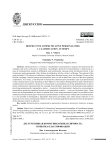
Destructive communicative personalities: a classification attempt
Статья научная
Destructiveness is viewed as a fundamental communicative category that determines the strategies and tactics of discourse interaction. Accordingly, destructive communication is understood as a type of communication aimed at deliberately and intentionally causing moral and physical harm to the interlocutor and accompanied with a feeling of satisfaction with the victim’s sufferings. The material of the study included 1120 contexts of reflection, selected from Russian literary texts, the National Corpus of the Russian Language, Internet sources and journalistic texts, as well as data from a survey of Russian-speaking respondents. As a result, a classification of destructive communicative personality types is proposed based on the communicative tactics prevailing in their behavior. The authors distinguish three types of destructive communicative personalities: destructive communicative personalities practicing predominantly invective tactics of destructive communication, for example, ham (the boor); destructive communicative personalities practicing predominantly manipulative tactics - shantazhist (the blackmailer); destructive communicative personalities practicing combined invective-and-manipulative tactics - revnivets (the jealous type). These tactics can be implemented in a direct or indirect form. In the analyzed material, there is a prevalence of the communicative personality type who practices predominantly invective tactics of destructive communication. It is also possible to distinguish a potentially destructive personality type whose initial intention is not destructive, but whose communicative behavior can be eventually qualified as destructive from the perspective of the addresser and/or an observer.
Бесплатно
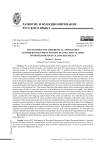
Статья научная
The article presents fundamental positions of the linguistic school by Sofiya P. Lopushanskaya, Professor of Volgograd State University, and describes their theoretical advancement as being applied in the discourse studies on “Document text: history and modern state”. It explains that the study of business and administrative communication should be based on a clarified definition of the term document as its main constituent. The major goal of documental linguistics is to process a diverse linguistic analysis, discover objective knowledge and reason linguistic comprehension of the documental nature of communication. Within the framework of this review, some general principles of the document text analysis are presented. Firstly, they are statements on: the unity of the speech-making process approach; the interaction and coordination between language phenomena and speech production processes; extralinguistic determination of the modern document. Secondly, these statements were particularized in the linguistic school of Volgograd State University with the aim of introducing basic approaches to the study of the document text. They involve identifying the research object and its characteristics, analyzing a diverse range of texts to assess the genre and style productivity of the document text equally, and defining linguistic categories that are manifested in textual and lingual specificity. The article presents renewed facts on discursive and linguistic features of modern documents united by such text properties as consistency, structure, locality, peculiarities of the language representation of the author and addressee. It is noted that the text of the document can contain information of various qualitative types (factual, conceptual, subtextual), and it is the main constituent of the documental system and the business and administrative communication act. As the text reflects an objective and social reality, its compositional structure and semantic realization greatly depend on extralinguistic constrains. The profiles of the author (addresser) and addressee are presented as being reconstructed with the detailed observation of multi-level lingual and discursive means. The variability of the addressee profiles (the document text addressability) is presented in models of lexical, style, and text adaptation. The principles and methods of detailed description of the documet text specified in the article open up new opportunities and directions for studying document typology and distinguishing relevant features of the document communication.
Бесплатно
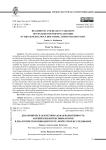
Статья научная
The article presents a corpus-based study of the diachronic and dialect variations of adverbial intensifiers used as the expression of emotionality that is a key defining feature of interpersonal conversation in the British and American film discourse. Based on the corpora of scripts of British and American feature films released in the 1930-1950s and 1990-2010s, data on the frequency of adverbial intensifiers in the sub-corpora of the English regional varieties of the two periods were obtained and their comparative analysis was carried out to establish the regional specifics and historical dynamics of their use; the collocation profiles of adverbial intensifiers that form syntagmatic units in the dialogic speech of British and American film discourse for each of the studied periods were described; semantic classes and stylistic characteristics of adjectives that form the most frequent collocations with the intensifiers were identified; the pragmalinguistic potential of the intensifiers and adjectives to indicate informality and emotionality in the dialogues of the English film discourse was determined. The diachronic analysis revealed a decline in the occurrences of the standard register intensifiers ( terribly , awfully , perfectly , extremely , etc.) with adjectives carrying the semantics of general evaluation, opinion, judgment, and emotionality in both corpora of modern English film discourse. In the 1990-2010s period, the process of renewal is observed in the UK and US film discourse when formerly frequent intensifiers are seen to be replaced by informal adverbs with a maximal degree of emotionality in speakers’ attitudes to situations, objects of the surrounding world and the interlocutor, which reflects a trend in preference towards the colloquial and substandard stylistic register. The growth of substandard vocabulary indicates that this trend is in line with the expectations of the English-speaking discursive communities that perceive film discourse as a reflection of authentic face-to-face discursive practices.
Бесплатно
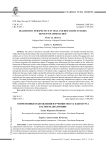
Diachronic perspective in text and discourse studies: review of approaches
Статья научная
The article is devoted to scientific observation of historically- and socially-oriented discourse studies (historical discoursology) that are presented by means of various approaches and research traditions. The authors give a review of several well-established subfields in diachronic discourse studies of language units and text types, namely historical pragmatics, historical text linguistics, diachronic discourse analysis, with the focus on the tools and methodology employed to investigate historical changes in language-in-use practice. It is stated that in Russian linguistics the diachronic aspect of language units functioning has been studied so far within the framework of diachronic stylistics with the purpose to define via the analysis of language unit realizations semantic and functional potentials of language units and text constituents, to distinguish text composition with its dependency on social and cultural circumstances of text production, to discover synchronic / diachronic perspectives in general and specific discourse categories evolution. The authors make a suggestion that the use of corpus methods in the diachronic discourse studies might considerably enhance the perspectives of finding out some prototypical features of discourse and their historical variations, if a research is based on text collections (text data) that are being analyzed with the corpus analysis protocols, strictly set historical periods and general reference to a certain textual cultures. The clearly defined corpus data could certainly help in retrieving information on cognitive, social, cultural, pragmatic aspects of the discourse type represented in the text collection of a historical period under study. The further comparison of the data in particular historical periods and / or regional references opens the ways for discovering diachronic vectors in the discourse type development through stating changes, transformations, replacements in the discursive forms and genres.
Бесплатно
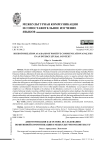
Dichotomization as a basis of positive communication analysis in an intercultural context
Статья научная
The aim of the paper is to investigate the constituent features and mechanisms of positive communication and reveal their correlation with politeness. The study is based on a mixed-method research design including Positive Discourse Analysis, dichotomic division and conversational analysis, and is carried out on the material of the book The Family by Nina Fedorova (1940). The results indicate that the dichotomy positive vs negative attitude is basic for the study and implements the contrast between good and evil, ethical and unethical behaviour. The juxtaposition of attraction vs disattraction refers to the perception of an interlocutor as likable or unlikable. The dichotomy activism vs passivism reflects the willingness or unwillingness to interact, while communication involvement vs alienation is associated with the communicator's engagement in the interlocutor's affairs. The juxtaposition of alterocentrism vs egocentrism indicates whether a communicator is focused on one's own or other people's interests. The dichotomy social support vs social indifference is a reflection of empathy or its absence. In the dichotomy constructive vs destructive communication creative behaviour aimed at resolving a difficult situation is opposed to destructive actions leading to the deterioration or break-up of a relationship. Оne of the most important constituents of positive communication is congruency which denotes authenticityand correspondence of the person's genuine inner selfwith the image addressed to the outer world. Positive communication is intrinsically linked with, though not identical to, politeness. The latter does not act as an aim per se, but is rather a tool employed to make an interaction conflict-free, smooth and harmonious.
Бесплатно
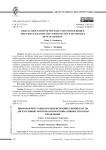
Статья научная
The paper discusses the communicative techniques of reputation management of the executive power bodies in the Russian media space. Comparing the concepts of digital reputation and digital image, the authors argue that, unlike image which is purposefully implemented in the media environment, reputation reflects the internet users' real opinion about the activities performed by state institutions. The essential features of digital reputation are accumulative character, unpredictability and inertia. The authors define the discursive factors affecting reputation: ambiguously wide audience of the internet, distribution of target groups on different web sites, the unpredictability of users' assessments, some citizens' aggressive speech behaviour, etc. More than 2.5 thousand posts by the Ministry of Science and Higher Education of the Russian Federation published in the VKontakte social network and Telegram messenger were selected as the material for the research. The impact of content on the internet audience was evaluated with the ERpost rate at the Popsters service. The authors argue that effective techniques of digital reputation management are the following: communication on a particular internet platform with regard to its target audience, attractive hashtags, the tone of involvement with the interlocutor, rejection of formal style clichйs, and some others. The discursive factors of new formal communication are established, and the techniques of managing governmental bodies' positive digital reputation are described.
Бесплатно

